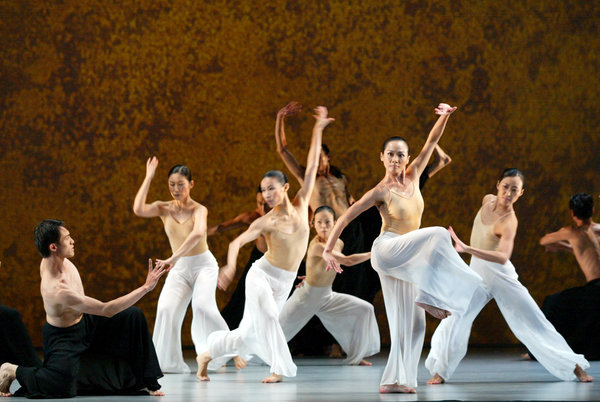Cloud Gate dancers bring 'Cursive' to Beijing
 |
|
Cloud Gate dancers rehearse "Cursive." [CFP] |
The work, created in 2001, is the first in Lin's "Cursive: A Trilogy" series, combining his signature blend of East and West. This month's tour will be the first time that "Cursive" is being performed in its entirety on the mainland.
Lin and his company are known for their interpretation of folklore, literature and Chinese culture. In the 1990s, Li began to draw on the concept of chi, or energy. Cloud Gate dancers continuously practice meditation, martial arts and Tai Chi Tao Yin, an ancient Chi Kung exercise, all taught by old masters.
"Cloud Gate dancers are more close to the practice of Buddhism than dancing," Lin explained during a lecture "Talking About 'The Cursive'" held at the National Center for the Performing Arts (NCPA) November 1. "A dancer should be sensitive to the changes in his or her body."
Inspired by calligraphy, Lin utilized the dancing movements of calligraphers and their brush strokes to create his cursive series. He also added weekly calligraphy classes to the dancers' regime.
Lin then asked Cloud Gate dancers to improvise using enlarged images of calligraphy. The dancers absorb the chi from the images and imitated the flow of the brush strokes, expressing lyrical dynamism and punctuations with rich variations in energy.
"What they see is not only the strokes of characters, but also how ancient masters used their writing brush and chi, the energy," Lin explained.
Although without a story or a plot, Cloud Gate's performances touch the audience with the inherent beauty of every scene. Once, an audience member told Lin that he had goose bumps throughout the show, although he did not understand the dance completely.
During his lecture Lin explained that he believes dancing should be part of the community, at every level.
"Dancing should be directly related to life. The audiences can be encouraged, moved and inspired, but first of all, you have to go outside," he said.
Touring the world for several months a year, Cloud Gate performs throughout Taiwan for the majority of their time, from large opera houses in big cities to high school auditoriums in remote villages. The company also gives free outdoor performances several times a year, drawing audiences of up to 60,000 each performance.
 0 Comments
0 Comments







Comments